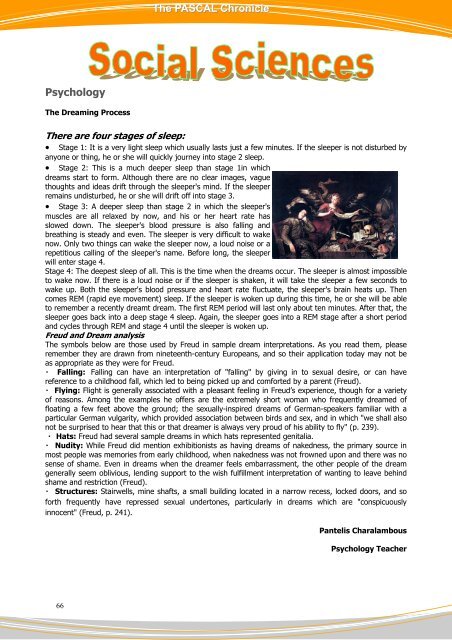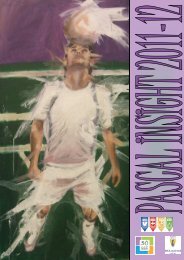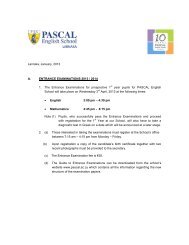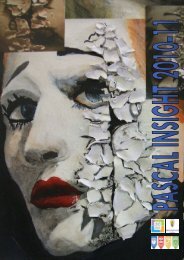Chronicle
The PASCAL Chronicle 2012-13 - Pascal Education
The PASCAL Chronicle 2012-13 - Pascal Education
Create successful ePaper yourself
Turn your PDF publications into a flip-book with our unique Google optimized e-Paper software.
The PASCAL <strong>Chronicle</strong>PsychologyThe Dreaming ProcessThere are four stages of sleep:Stage 1: It is a very light sleep which usually lasts just a few minutes. If the sleeper is not disturbed byanyone or thing, he or she will quickly journey into stage 2 sleep. Stage 2: This is a much deeper sleep than stage 1in whichdreams start to form. Although there are no clear images, vaguethoughts and ideas drift through the sleeper's mind. If the sleeperremains undisturbed, he or she will drift off into stage 3. Stage 3: A deeper sleep than stage 2 in which the sleeper'smuscles are all relaxed by now, and his or her heart rate hasslowed down. The sleeper's blood pressure is also falling andbreathing is steady and even. The sleeper is very difficult to wakenow. Only two things can wake the sleeper now, a loud noise or arepetitious calling of the sleeper's name. Before long, the sleeperwill enter stage 4.Stage 4: The deepest sleep of all. This is the time when the dreams occur. The sleeper is almost impossibleto wake now. If there is a loud noise or if the sleeper is shaken, it will take the sleeper a few seconds towake up. Both the sleeper's blood pressure and heart rate fluctuate, the sleeper's brain heats up. Thencomes REM (rapid eye movement) sleep. If the sleeper is woken up during this time, he or she will be ableto remember a recently dreamt dream. The first REM period will last only about ten minutes. After that, thesleeper goes back into a deep stage 4 sleep. Again, the sleeper goes into a REM stage after a short periodand cycles through REM and stage 4 until the sleeper is woken up.Freud and Dream analysisThe symbols below are those used by Freud in sample dream interpretations. As you read them, pleaseremember they are drawn from nineteenth-century Europeans, and so their application today may not beas appropriate as they were for Freud.・ Falling: Falling can have an interpretation of "falling" by giving in to sexual desire, or can havereference to a childhood fall, which led to being picked up and comforted by a parent (Freud).・ Flying: Flight is generally associated with a pleasant feeling in Freud’s experience, though for a varietyof reasons. Among the examples he offers are the extremely short woman who frequently dreamed offloating a few feet above the ground; the sexually-inspired dreams of German-speakers familiar with aparticular German vulgarity, which provided association between birds and sex, and in which "we shall alsonot be surprised to hear that this or that dreamer is always very proud of his ability to fly" (p. 239).・ Hats: Freud had several sample dreams in which hats represented genitalia.・ Nudity: While Freud did mention exhibitionists as having dreams of nakedness, the primary source inmost people was memories from early childhood, when nakedness was not frowned upon and there was nosense of shame. Even in dreams when the dreamer feels embarrassment, the other people of the dreamgenerally seem oblivious, lending support to the wish fulfillment interpretation of wanting to leave behindshame and restriction (Freud).・ Structures: Stairwells, mine shafts, a small building located in a narrow recess, locked doors, and soforth frequently have repressed sexual undertones, particularly in dreams which are "conspicuouslyinnocent" (Freud, p. 241).Pantelis CharalambousPsychology Teacher66
















